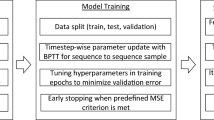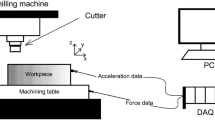Abstract
Grinding with metal-bonded cBN grinding tools enables a long lifetime without any need for redressing. However, the lifetime strongly varies and a precise estimation of the remaining number of parts to be machined is an essential contribution to efficient industrial manufacturing. Previous studies focus mainly on the separation of two or three tool wear categories by the application of traditional machine learning methods while achieving a good accuracy of the prediction. In this work, a tool condition monitoring system is proposed to obtain more than 1500 statistical features from several sensors, which represent the characteristics of the performed grinding process. In contrast to most previous studies, a regression task is formulated to estimate the remaining useful tool lifetime, which is determined by the occurrence of strong grinding burn. Two machine learning concepts are compared in this study comprising an ensemble tree-based method and a custom deep state space model based on recurrent neural networks. Using first the signal-based features only, a good estimation quality for both models could be achieved. In addition, the features are extended by physical knowledge coming from a surrogate model of a kinematic geometrical process model and some well-known physical relationships. Using this hybrid machine learning framework, the same models are evaluated again. The prediction quality of the models could be improved significantly resulting in a mean \(R^{2}\) score of more than 0.95.















Similar content being viewed by others
References
Denkena B, Krödel A, Wilckens M (2021) High performance peel grinding of steel shafts using coarse electroplated CBN grinding wheels. Prod Eng 15:717–724. https://doi.org/10.1007/s11740-021-01047-1
Wegener K, Hoffmeister HW, Karpuschewski B, Kuster F, Hahmann WC, Rabiey M (2011) Conditioning and monitoring of grinding wheels. CIRP Annals 60(2):757–777. https://doi.org/10.1016/j.cirp.2011.05.003
Malkin S, Guo C (2008) Grinding technology: theory and application of machining with abrasives, 2nd edn. Industrial Press. ISBN 978-0-83-1192204
Yoshida T, Karasawa H, Fukui R, Fujii K, Warisawa S (2021) Analysis of chip size distribution using image processing technology to estimate wear state of cylindrical grinding wheel. Tribology International 153:106600. https://doi.org/10.1016/j.triboint.2020.106600
Sauter E, Winter M, Sarikaya E, Wegener K (2021) In-process detection of grinding burn using machine learning. Int J Adv Manuf Technol 115:2281–2297. https://doi.org/10.1007/s00170-021-06896-9
Sauter E, Winter M, Wegener K (2022) Analysis of robustness and transferability in feature-based grinding burn detection. Int J Adv Manuf Technol 120:2587–2602. https://doi.org/10.1007/s00170-022-08834-9
Serin G, Sener B, Ozbayoglu AM, Unver HO (2020) Review of tool condition monitoring in machining and opportunities for deep learning. Int J Adv Manuf Technol 109(3–4):953–974. https://doi.org/10.1007/s00170-020-05449-w
Nathan RD, Vijayaraghavan L, Krishnamurthy R (1999) In-process monitoring of grinding burn in the cylindrical grinding of steel. J Mater Process Technol 91(1–3):37–42. https://doi.org/10.1016/S0924-0136(98)00408-7
Lezanski P (2001) An intelligent system for grinding wheel condition monitoring. J Mater Process Technol 109(3):258–263. https://doi.org/10.1016/S0924-0136(00)00808-6
Liao TW, Hua G, Qu J, Blau PJ (2007) Grinding wheel condition monitoring with hidden Markov model-based clustering methods. Mach Sci Technol 10(4):511–538. https://doi.org/10.1080/10910340600996175
Yang Z, Yu Z (2012) Grinding wheel wear monitoring based on wavelet analysis and support vector machine. Int J Adv Manuf Technol 62(1):107–121. https://doi.org/10.1007/s00170-011-3797-1
Arriandiaga A, Portillo E, Sánchez J, Cabanes I, Pombo I (2014) Virtual sensors for on-line wheel wear and part roughness measurement in the grinding process. Sensors 14(5):8756–8778
Arun A, Rameshkumar K, Unnikrishnan D, Sumesh A (2018) Tool condition monitoring of cylindrical grinding process using acoustic emission sensor. Materials Today: Proceedings 5(5, Part 2):11888–11899, 10.1016/j.matpr.2018.02.162, International Conference on Materials Manufacturing and Modelling, ICMMM - 2017, 9–11, March 2017. https://doi.org/10.1016/j.matpr.2018.02.162
Guo W, Li B, Zhou Q (2019) An intelligent monitoring system of grinding wheel wear based on two-stage feature selection and long short-term memory network. Proc Inst Mech Eng 233(13):2436–2446. https://doi.org/10.1177/0954405419840556
Lee CH, Jwo JS, Hsieh HY, Lin CS (2020) An intelligent system for grinding wheel condition monitoring based on machining sound and deep learning. IEEE Access 8:58279–58289. https://doi.org/10.1109/ACCESS.2020.2982800
Zhang B, Katinas C, Shin YC (2020) Robust wheel wear monitoring system for cylindrical traverse grinding. IEEE/ASME Transactions on Mechatronics 25(5):2220–2229. https://doi.org/10.1109/TMECH.2020.3007047
Rameshkumar K, Mouli D, Shivith K (2021) Machine learning models for predicting grinding wheel conditions using acoustic emission features. SAE Int J Manuf Mater Mech 14(4):387–406. https://doi.org/10.4271/05-14-04-0026
Mahata S, Shakya P, Babu NR (2021) A robust condition monitoring methodology for grinding wheel wear identification using Hilbert Huang transform. Prec Eng 70:77–91. https://doi.org/10.1016/j.precisioneng.2021.01.009
Sachin Krishnan P, Rameshkumar K (2021) Grinding wheel condition prediction with discrete hidden Markov model using acoustic emission signature. Materials Today: Proceedings 46:9168–9175. Int Mech Eng Congress 2019. https://doi.org/10.1016/j.matpr.2019.12.428
Yin C, Wang Y, Lee HP, He J, He Y, Sun Y (2021) Robust wheel wear detection for solid carbide grinding under strong noise interference: a new approach based on improved ensemble noise-reconstructed empirical mode decomposition. Wear 486–487. https://doi.org/10.1016/j.wear.2021.204112
Brinksmeier E, Aurich J, Govekar E, Heinzel C, Hoffmeister HW, Klocke F, Peters J, Rentsch R, Stephenson D, Uhlmann E, Weinert K, Wittmann M (2006) Adv Model Simul Grind Process CIRP Annals 55(2):667–696. https://doi.org/10.1016/j.cirp.2006.10.003
Winter M (2016) Eco-efficiency of grinding processes and systems. Springer, Cham. https://doi.org/10.1007/978-3-319-25205-6
Darafon A (2013) Measuring and modeling of grinding wheel topography. PhD thesis, Dalhousie University. http://hdl.handle.net/10222/21678. Accessed 19 Oct 2021
Rabiey M (2011) Dry grinding with CBN wheels, the effect of structuring. PhD thesis, University of Stuttgart. https://doi.org/10.18419/opus-4429
Wang D, Ge P, Bi W, Jiang J (2014) Grain trajectory and grain workpiece contact analyses for modeling of grinding force and energy partition. Int J Adv Manuf Technol 70(9):2111–2123. https://doi.org/10.1007/s00170-013-5428-5
Rowe WB (2009) Principles of modern grinding technology, 1st edn. William Andrew. https://books.google.de/books?id=x1wdlQEACAAJ
Jermolajev S, Epp J, Heinzel C, Brinksmeier E (2016) Material modifications caused by thermal and mechanical load during grinding. In: 3rd CIRP Conference on Surface Integrity 45:43–46. https://doi.org/10.1016/j.procir.2016.02.159
Spriggs GE (2002) Properties of diamond and cubic boron nitride: datasheet from Landolt-Börnstein, vol 2A2. Springer-Verlag, Berlin Heidelberg, 13:102–107. https://doi.org/10.1007/108586417
Deutsche Edelstahlwerke GmbH (2011) Datenblatt. Online. https://www.dew-stahl.com/fileadmin/files/dew-stahl.com/documents/Publikationen/Werkstoffdatenblaetter/Baustahl/1.1191_1.1201_de.pdf. Accessed 9 Nov 2022
Usui E, Shirakashi T, Kitagawa T (1984) Analytical prediction of cutting tool wear. Wear 100(1):129–151. https://doi.org/10.1016/0043-1648(84)90010-3
Kuffa M, Kuster F, Wegener K (2017) Stochastic kinematic process model with an implemented wear model for high feed dry grinding. Inventions 2(4):31. https://doi.org/10.3390/inventions2040031
Cavazzuti M (2013) Optimization methods. Springer, Berlin Heidelberg. https://doi.org/10.1007/978-3-642-31187-1
Bouhlel MA, Hwang JT, Bartoli N, Lafage R, Morlier J, Martins JRRA (2019) A Python surrogate modeling framework with derivatives. Adv Eng Softw 135. https://doi.org/10.1016/j.advengsoft.2019.03.005
Chen T, Guestrin C (2016) XGBoost: a scalable tree boosting system. CoRR. https://doi.org/10.1145/2939672.2939785
Krishnan RG, Shalit U, Sontag D (2016) Structured inference networks for nonlinear state space models. In: Thirty-First AAAI Conference on Artificial Intelligence. https://doi.org/10.48550/ARXIV.1609.09869
ISO14104:2017(E), (2017) Gears surface temper etch inspection after grinding, chemical method. Standard, International Organization for Standardization
Naik DN, Mathew NT, Vijayaraghavan L (2019) Wear of electroplated super abrasive CBN wheel during grinding of Inconel 718 super alloy. J Manuf Process 43:1–8. https://doi.org/10.1016/j.jmapro.2019.04.033
Author information
Authors and Affiliations
Corresponding author
Ethics declarations
Conflict of interest
On parts of this work, a patent was filed.
Rights and permissions
Springer Nature or its licensor (e.g. a society or other partner) holds exclusive rights to this article under a publishing agreement with the author(s) or other rightsholder(s); author self-archiving of the accepted manuscript version of this article is solely governed by the terms of such publishing agreement and applicable law.
About this article
Cite this article
Sauter, E., Sun, H., Winter, M. et al. Remaining useful lifetime estimation for metal-bonded grinding tools using hybrid machine learning. Int J Adv Manuf Technol 123, 3243–3260 (2022). https://doi.org/10.1007/s00170-022-10260-w
Received:
Accepted:
Published:
Issue Date:
DOI: https://doi.org/10.1007/s00170-022-10260-w




